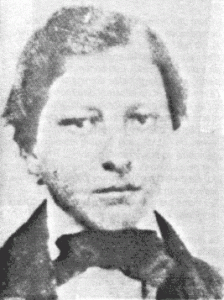Chapter 12. Children and Childhood
12.4 Childhood in the West

Historian of childhood Jennifer Brown pointed out years ago that the fur trade society brought together people who had experienced highly different childhoods. Many of the officers of the HBC were themselves orphans “recruited through the Grey Coat charity schools” of London.[1] Their connections with their peers in the company were strong, as were their relationships with Aboriginal women and wives. The HBC officers who settled at Red River did so with an eye to establishing a society near The Forks, an intergenerational community at the confluence of the Assiniboine and Red Rivers. They insisted that the company set aside resources for schooling, and when that was not forthcoming, they exercised what patriarchal authority they had in a strange land and had their métis sons shipped off to Britain for their education. Daughters stayed closer to home where they spent their childhood in a more Aboriginal-inflected environment.
The NWC traders did something similar. Those with connections to Montreal sent their sons and daughters alike to the St. Lawrence towns at a relatively young age. The work of Sylvia Van Kirk and Jennifer Brown on this topic suggests that Aboriginal mothers were highly critical of packing off children to remote educational institutions, which were, in any case, alien to their own experiences.[2] There was, however, the expectation that the children would return, not least so they could provide for their parents in retirement in the Red River Colony. Although the history of the fur trade in the West provides many examples of traders on fixed-term contracts who arrived, had relationships, and then departed, perhaps leaving their wives and children in the care of Aboriginal in-laws or a freshly appointed Euro-Canadian trader (a process sometimes called “turning off”), the record is also clear that many of these relationship (husband/wife; father/children) were anything but casual.
Aboriginal women approached parenting differently. First, the evidence suggests that they were accustomed to rearing fewer children. As Brown writes, Aboriginal families “were usually small, and children were commonly born three, four, or more years apart, owing to long periods of nursing that reduced the mothers’ fecundity and sometimes to post-partum taboos on sexual relations.”[3] Under these circumstances an Aboriginal child could expect something close to undivided maternal attention (certainly compared to the lot of their European contemporaries). Second, Aboriginal women engaged in co-mothering, at least outside of fur trade society. Once they were brought into the fold of the European posts and forts, Aboriginal mothers often found themselves caring singlehandedly for their young while the pressures to have more children in closer succession increased.
Fertility rates in the fur trade society were by all indications closer to the habitant model than to traditional practices among, say, the Anishinaabe. For children of the fur trade this meant having many siblings, and likely a good supply of uncles, aunts, and cousins as well. Some, usually the boys, identified more strongly with their European ancestry and culture, while others, particularly the girls, viewed themselves more as Aboriginal, although it is important to underline that no one rule applied.[4]
One can only imagine the cultural and linguistic complexity of many of these communities as they became intersections not only for European and Aboriginal relationships but Scots and Anishinaabe, French and Cree, Assiniboine and Sioux, English and Hawaiian, Iroquois and Secwepemc. By contrast, life in Toronto, Quebec, or Halifax may seem two-dimensional.
Childhood was critical to the formation of the Métis nation. French fathers commonly deserted their Aboriginal wives and children, as their understanding of marriages à la façon du pays was that they were not permanent and that the women might one day return to their families. This was, according to historians, the pattern, and for Aboriginal communities that recognized matrilineal descent, this was not (theoretically at least) a problem. In French fur trade communities like Fort Detroit, Michilimackinac, or Green Bay, however, there were other elements of European culture present: specifically, the clergy remained there for the long haul. The Church missions helped with housing, education, and culturally orienting significant numbers of Métis children of these marriages, which grounded them in a common vocabulary of Catholicism. Economically they were traders and hunters. Socially and culturally they were linked by very long tendrils to Montreal, pre-revolutionary France, and Rome.
Key Points
- In the 19th century fur trade society put a greater emphasis on formal schooling, a sign of the influence of European participants.
- Marriages between European men and Aboriginal women tended to produce larger families, which had an important impact on the experience of childhood.
Attributions
Figure 12.3
YoungLouisRiel by Ras67 is in the public domain.
- Jennifer S.H. Brown, “Children of the Early Fur Trades,” in Childhood and Family in Canadian History, ed. Joy Parr (Toronto: McClelland and Stewart, 1982), 44-68. ↵
- See, for example, Sylvia Van Kirk, “’The Custom of the Country’: An Examination of Fur Trade Marriage Practices,” in Canadian Family History: Selected Readings, ed. Bettina Bradbury (Mississauga: Copp Clark Pitman, 1992): 70-75. ↵
- Ibid., 48. ↵
- Ibid., 56. ↵

